Abstract
OBJECTIVE: To determine, for abdominal aortic aneurysm surgery, whether a previously reported relationship between hospital case volume and mortality rate was observed in Ontario hospitals and to assess the potential impact of age on the mortality rate for elective surgery. DESIGN: Population based observational study using administrative data. SETTING: All Ontario hospitals where repair of abdominal aortic aneurysm as a primary procedure was performed during 1988-92. PATIENTS: These comprised 5492 patients with unruptured abdominal aortic aneurysms and 1203 patients with ruptured abdominal aortic aneurysms admitted to hospital between 1988-92 for repair of abdominal aortic aneurysm as a primary procedure. MAIN OUTCOMES: In-hospital death and length of in-hospital stay. RESULTS: The case fatality rate was 3.8% for unruptured abdominal aortic aneurysms and 40.0% for ruptured abdominal aortic aneurysms. For unruptured cases, after adjustment for patient and hospital covariates, each 10 case per year increase in hospital volume was related to a 6% reduction in relative odds of death (odds ratio (OR) 0.94, 95% confidence intervals 0.88, 0.99) and 0.29 days reduction (95% CI -0.22, -0.35) in postoperative in-hospital stay. Female sex (OR 1.53, 95% CI 1.08, 2.18) and transfer from another acute care hospital (OR 4.37, 95% CI 2.62, 7.29) were associated with increased case fatality rates among patients in the unruptured category. For ruptured cases, neither the case fatality rate nor postoperative in-hospital stay were significantly related to hospital volume. The case fatality rates increased linearly and substantially with advancing age both for unruptured and ruptured aneurysms, and the excess risk of postoperative death in ruptured as compared to unruptured aneurysms was substantially higher in older patients. CONCLUSION: The relationship between hospital volume and mortality or morbidity was very modest and observed only for elective surgery. Case fatality rates in patients with ruptured abdominal aortic aneurysms remained 10 times higher than for patients with unruptured abdominal aortic aneurysms, despite improvements in overall mortality in comparison to previously published data. More effective detection of aneurysms, including elective repair for those once considered "high risk" older patients, might further reduce the toll from ruptured aortic aneurysms.
Full text
PDF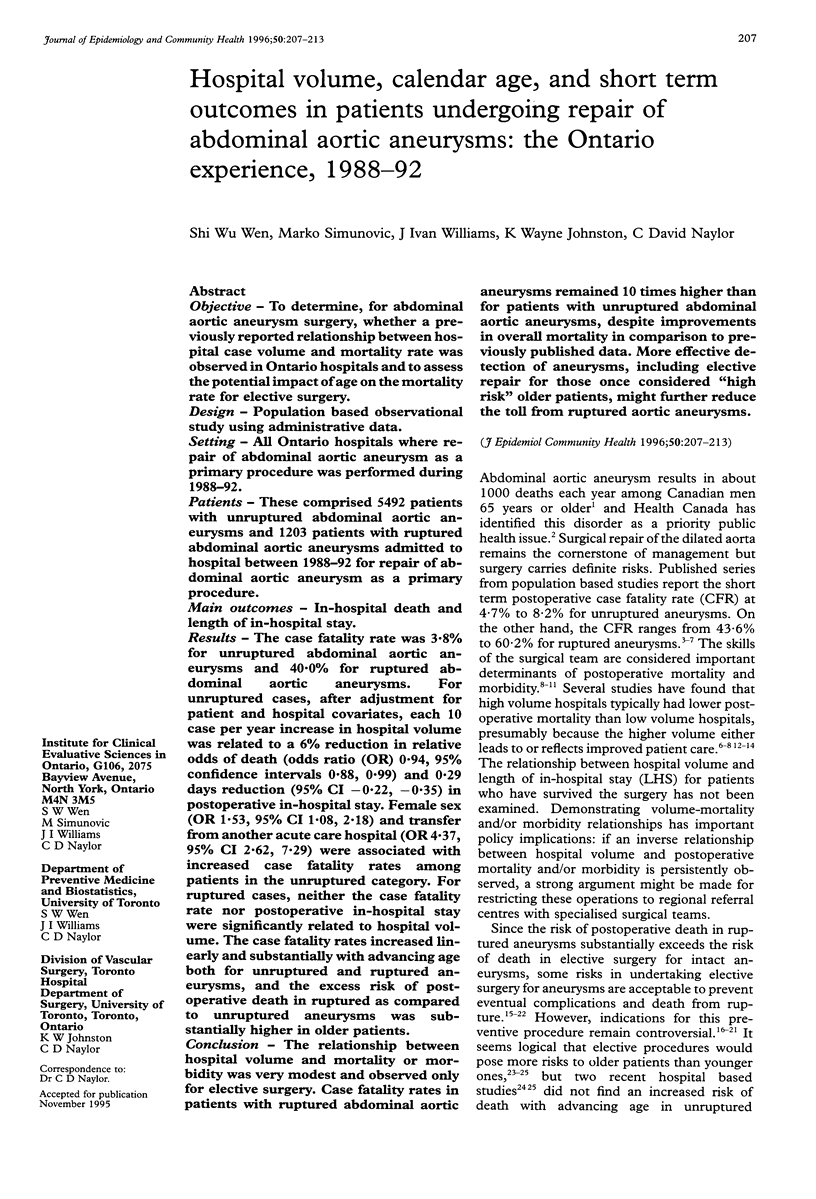
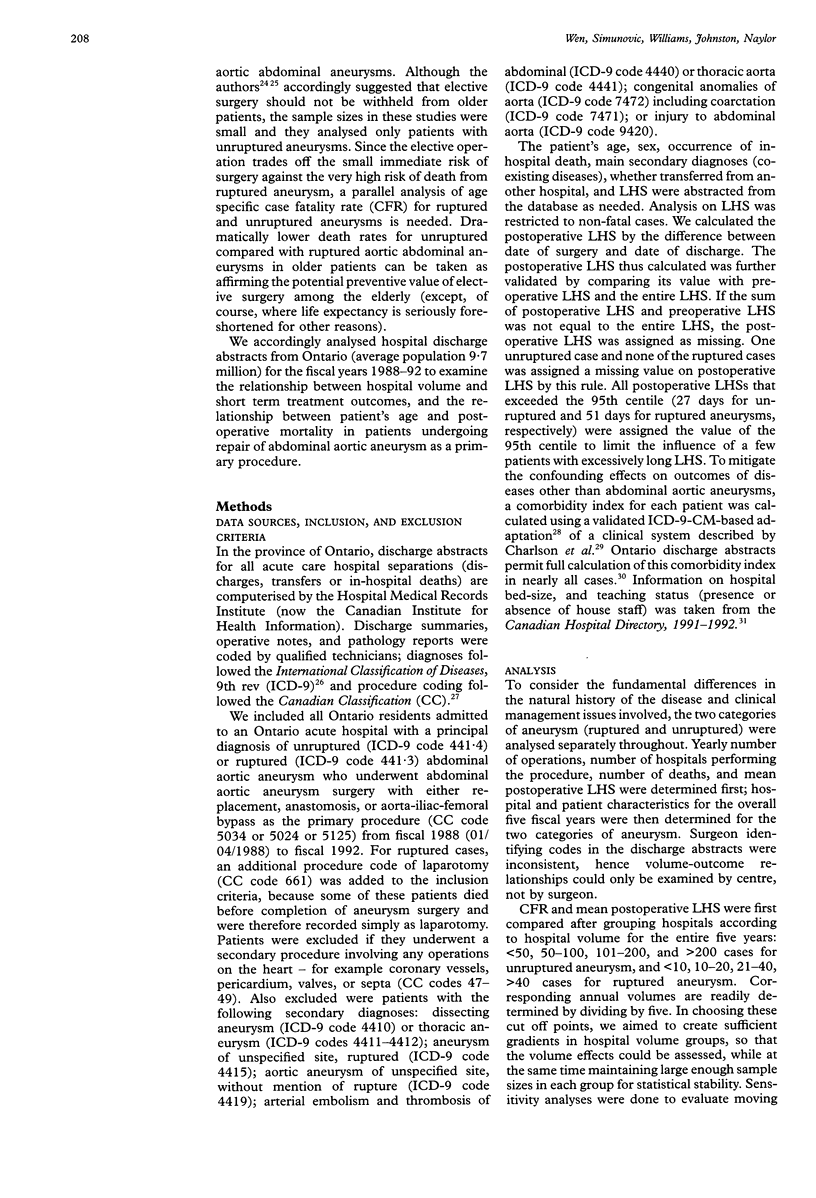
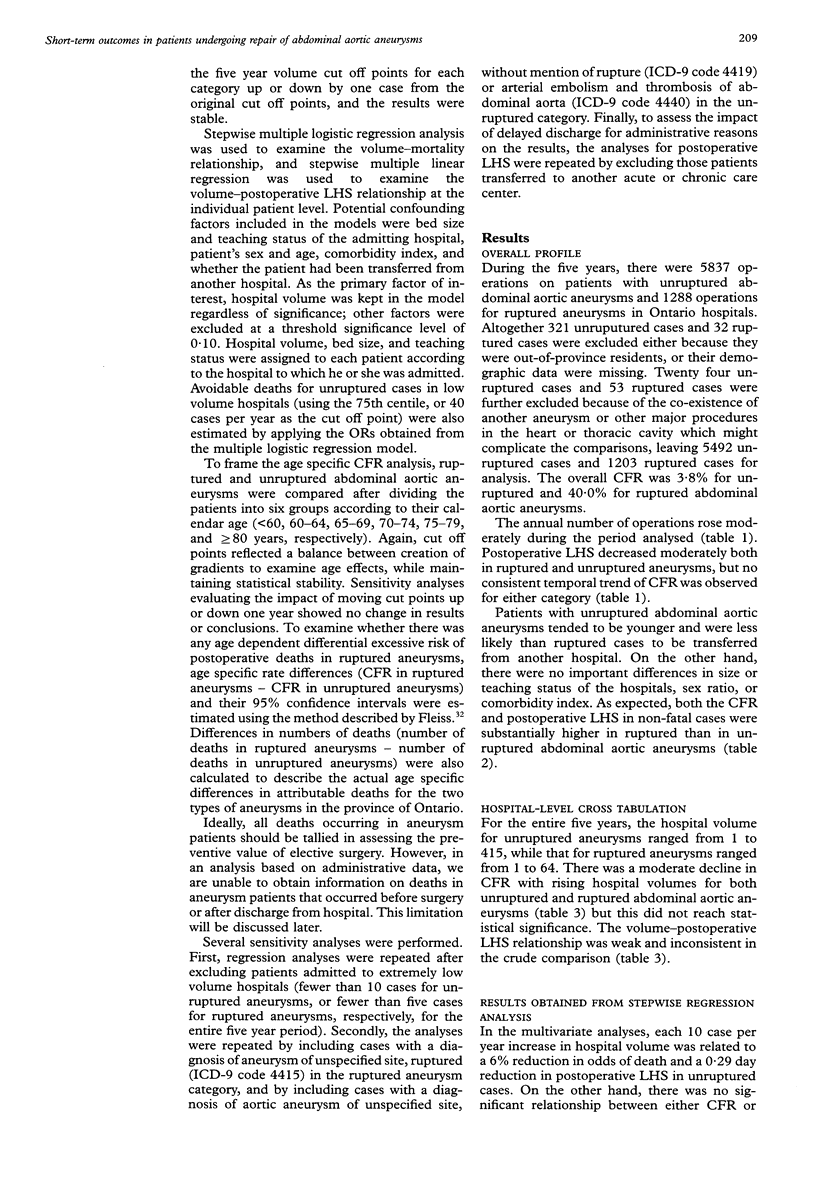
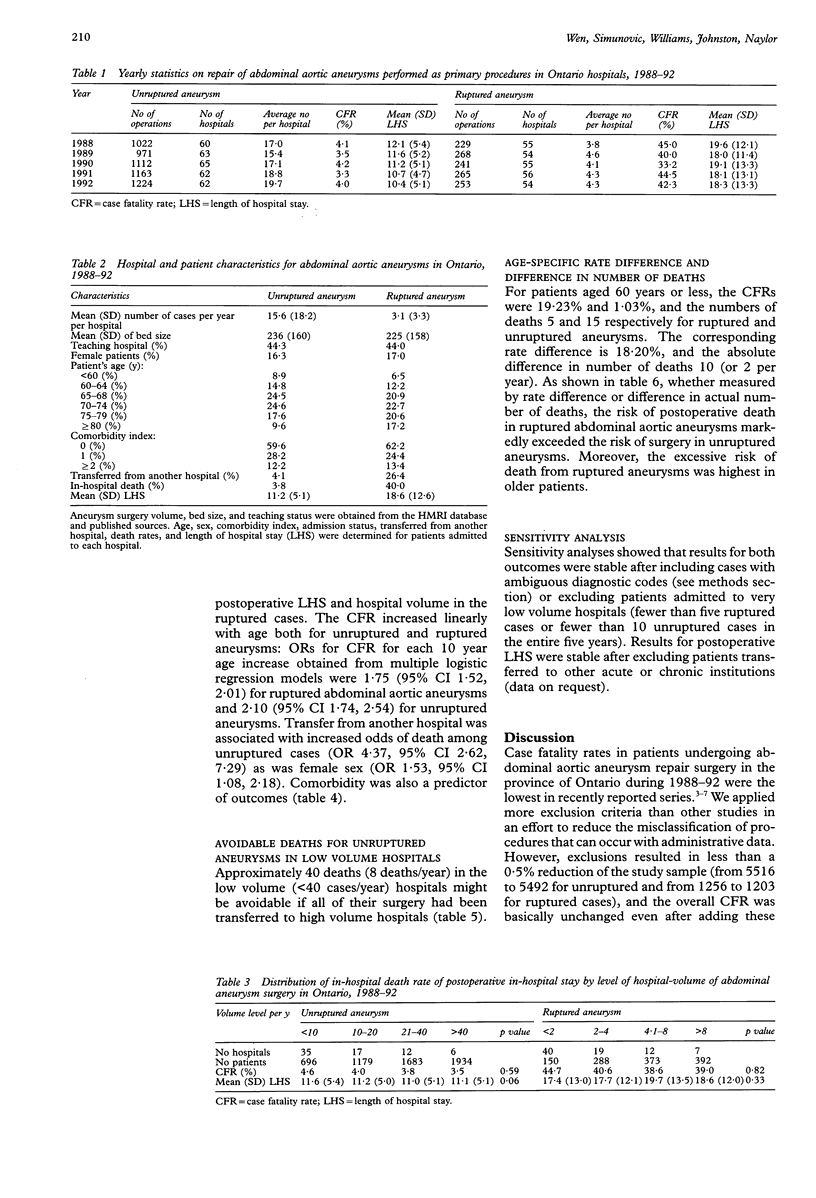
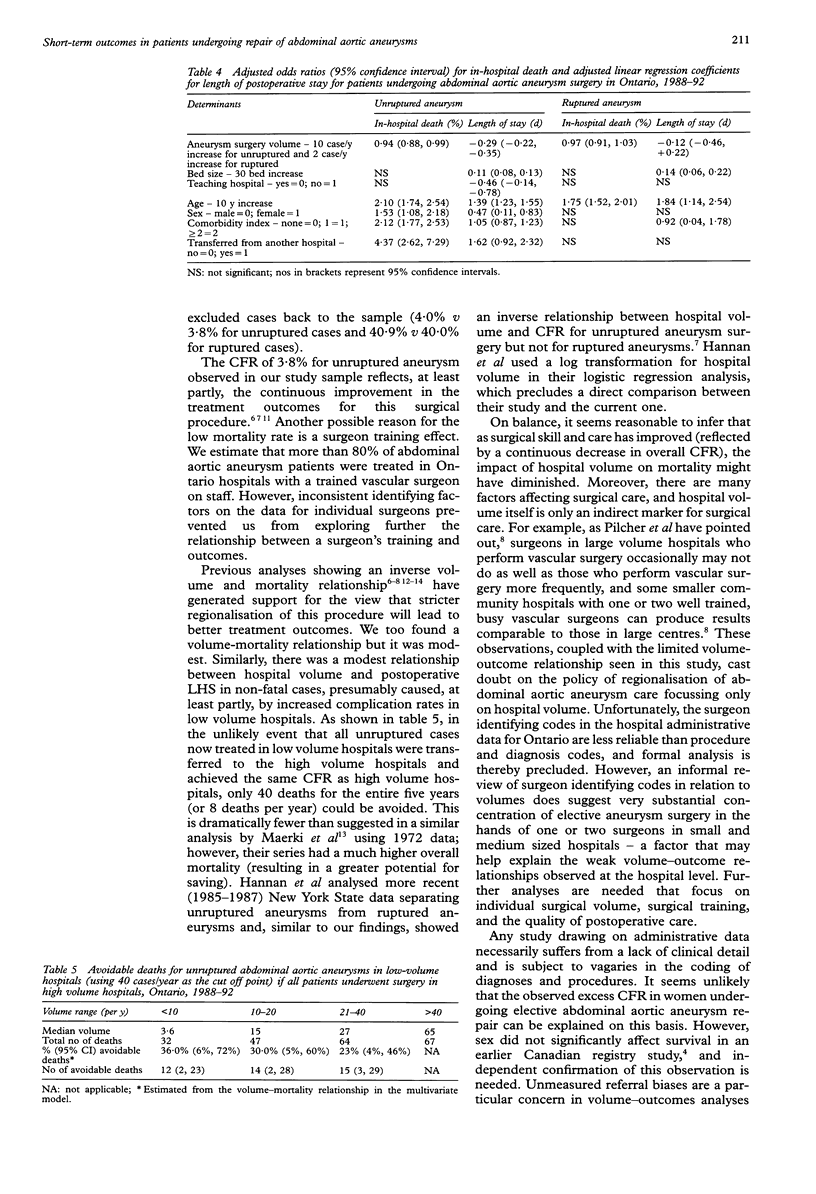
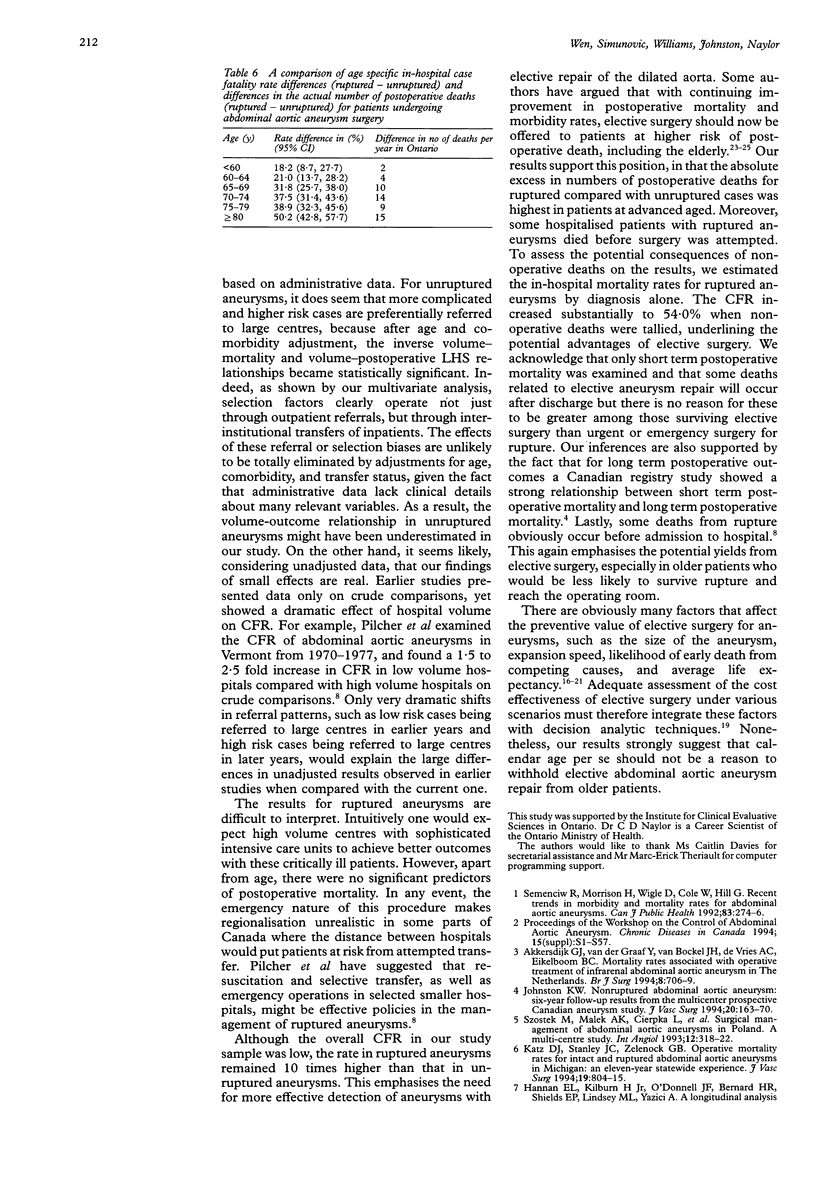
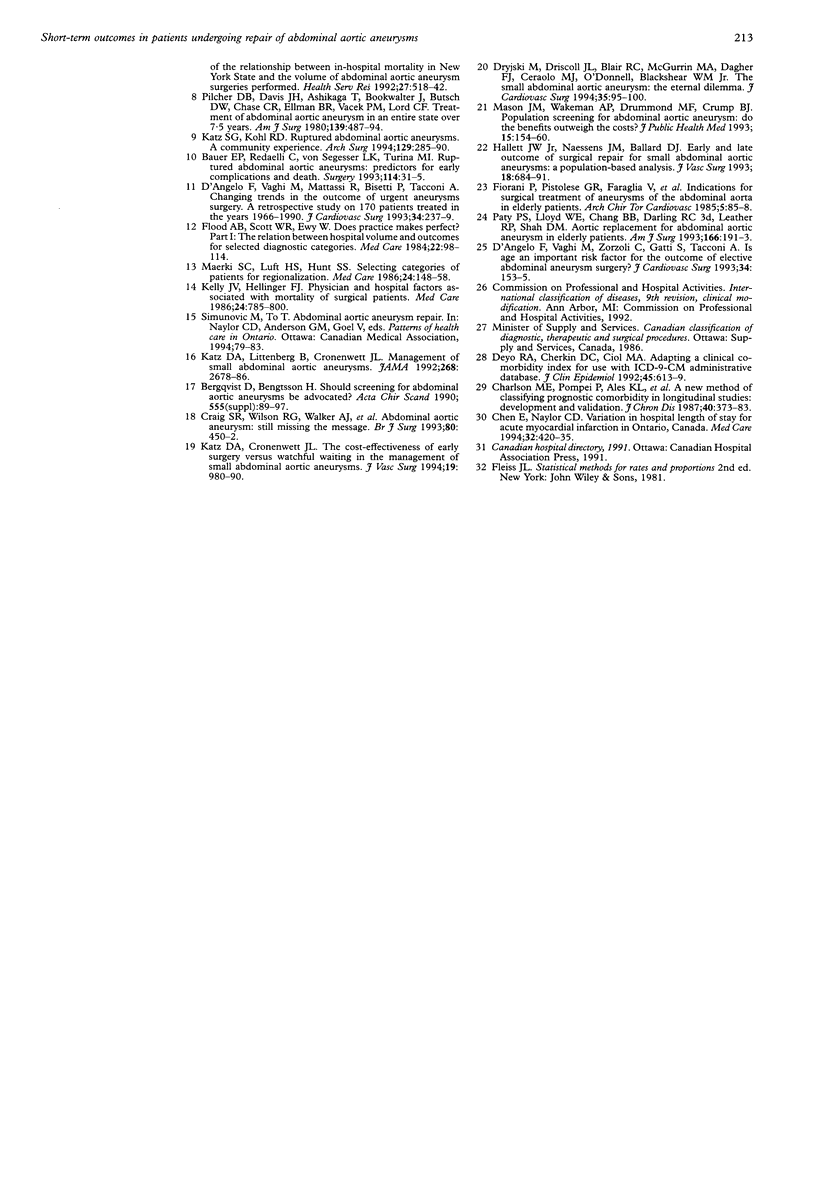
Selected References
These references are in PubMed. This may not be the complete list of references from this article.
- Akkersdijk G. J., van der Graaf Y., van Bockel J. H., de Vries A. C., Eikelboom B. C. Mortality rates associated with operative treatment of infrarenal abdominal aortic aneurysm in The Netherlands. Br J Surg. 1994 May;81(5):706–709. doi: 10.1002/bjs.1800810526. [DOI] [PubMed] [Google Scholar]
- Bauer E. P., Redaelli C., von Segesser L. K., Turina M. I. Ruptured abdominal aortic aneurysms: predictors for early complications and death. Surgery. 1993 Jul;114(1):31–35. [PubMed] [Google Scholar]
- Bergqvist D., Bengtsson H. Should screening for abdominal aortic aneurysms be advocated? Acta Chir Scand Suppl. 1990;555:89–97. [PubMed] [Google Scholar]
- Charlson M. E., Pompei P., Ales K. L., MacKenzie C. R. A new method of classifying prognostic comorbidity in longitudinal studies: development and validation. J Chronic Dis. 1987;40(5):373–383. doi: 10.1016/0021-9681(87)90171-8. [DOI] [PubMed] [Google Scholar]
- Chen E., Naylor C. D. Variation in hospital length of stay for acute myocardial infarction in Ontario, Canada. Med Care. 1994 May;32(5):420–435. doi: 10.1097/00005650-199405000-00002. [DOI] [PubMed] [Google Scholar]
- Craig S. R., Wilson R. G., Walker A. J., Murie J. A. Abdominal aortic aneurysm: still missing the message. Br J Surg. 1993 Apr;80(4):450–452. doi: 10.1002/bjs.1800800413. [DOI] [PubMed] [Google Scholar]
- D'Angelo F., Vaghi M., Mattassi R., Bisetti P., Tacconi A. Changing trends in the outcome of urgent aneurysms surgery. A retrospective study on 170 patients treated in the years 1966-1990. J Cardiovasc Surg (Torino) 1993 Jun;34(3):237–239. [PubMed] [Google Scholar]
- D'Angelo F., Vaghi M., Zorzoli C., Gatti S., Tacconi A. Is age an important risk factor for the outcome of elective abdominal aneurysm surgery? J Cardiovasc Surg (Torino) 1993 Apr;34(2):153–155. [PubMed] [Google Scholar]
- Deyo R. A., Cherkin D. C., Ciol M. A. Adapting a clinical comorbidity index for use with ICD-9-CM administrative databases. J Clin Epidemiol. 1992 Jun;45(6):613–619. doi: 10.1016/0895-4356(92)90133-8. [DOI] [PubMed] [Google Scholar]
- Dryjski M., Driscoll J. L., Blair R. C., McGurrin M. A., Dagher F. J., Ceraolo M. J., O'Donnell, Blackshear W. M., Jr The small abdominal aortic aneurysm: the eternal dilemma. J Cardiovasc Surg (Torino) 1994 Apr;35(2):95–100. [PubMed] [Google Scholar]
- Flood A. B., Scott W. R., Ewy W. Does practice make perfect? Part I: The relation between hospital volume and outcomes for selected diagnostic categories. Med Care. 1984 Feb;22(2):98–114. [PubMed] [Google Scholar]
- Hallett J. W., Jr, Naessens J. M., Ballard D. J. Early and late outcome of surgical repair for small abdominal aortic aneurysms: a population-based analysis. J Vasc Surg. 1993 Oct;18(4):684–691. [PubMed] [Google Scholar]
- Johnston K. W. Nonruptured abdominal aortic aneurysm: six-year follow-up results from the multicenter prospective Canadian aneurysm study. Canadian Society for Vascular Surgery Aneurysm Study Group. J Vasc Surg. 1994 Aug;20(2):163–170. doi: 10.1016/0741-5214(94)90002-7. [DOI] [PubMed] [Google Scholar]
- Katz D. A., Cronenwett J. L. The cost-effectiveness of early surgery versus watchful waiting in the management of small abdominal aortic aneurysms. J Vasc Surg. 1994 Jun;19(6):980–991. doi: 10.1016/s0741-5214(94)70209-8. [DOI] [PubMed] [Google Scholar]
- Katz D. A., Littenberg B., Cronenwett J. L. Management of small abdominal aortic aneurysms. Early surgery vs watchful waiting. JAMA. 1992 Nov 18;268(19):2678–2686. [PubMed] [Google Scholar]
- Katz D. J., Stanley J. C., Zelenock G. B. Operative mortality rates for intact and ruptured abdominal aortic aneurysms in Michigan: an eleven-year statewide experience. J Vasc Surg. 1994 May;19(5):804–817. doi: 10.1016/s0741-5214(94)70005-2. [DOI] [PubMed] [Google Scholar]
- Katz S. G., Kohl R. D. Ruptured abdominal aortic aneurysms. A community experience. Arch Surg. 1994 Mar;129(3):285–290. doi: 10.1001/archsurg.1994.01420270061014. [DOI] [PubMed] [Google Scholar]
- Kelly J. V., Hellinger F. J. Physician and hospital factors associated with mortality of surgical patients. Med Care. 1986 Sep;24(9):785–800. doi: 10.1097/00005650-198609000-00001. [DOI] [PubMed] [Google Scholar]
- Maerki S. C., Luft H. S., Hunt S. S. Selecting categories of patients for regionalization. Implications of the relationship between volume and outcome. Med Care. 1986 Feb;24(2):148–158. doi: 10.1097/00005650-198602000-00006. [DOI] [PubMed] [Google Scholar]
- Mason J. M., Wakeman A. P., Drummond M. F., Crump B. J. Population screening for abdominal aortic aneurysm: do the benefits outweigh the costs? J Public Health Med. 1993 Jun;15(2):154–160. [PubMed] [Google Scholar]
- Paty P. S., Lloyd W. E., Chang B. B., Darling R. C., 3rd, Leather R. P., Shah D. M. Aortic replacement for abdominal aortic aneurysm in elderly patients. Am J Surg. 1993 Aug;166(2):191–193. doi: 10.1016/s0002-9610(05)81054-2. [DOI] [PubMed] [Google Scholar]
- Pilcher D. B., Davis J. H., Ashikaga T., Bookwalter J., Butsch D. W., Chase C. R., Ellman B. R., Vacek P. M., Lord C. F. Treatment of abdominal aortic aneurysm in an entire state over 7 1/2 years. Am J Surg. 1980 Apr;139(4):487–494. doi: 10.1016/0002-9610(80)90325-6. [DOI] [PubMed] [Google Scholar]
- Semenciw R., Morrison H., Wigle D., Cole W., Hill G. Recent trends in morbidity and mortality rates for abdominal aortic aneurysms. Can J Public Health. 1992 Jul-Aug;83(4):274–276. [PubMed] [Google Scholar]
- Szostek M., Malek A. K., Cierpka L., Glowinski S., Mackiewicz Z., Michalak J., Noszczyk W., Skora K., Witkiewicz W., Zapalski S. Surgical management of abdominal aortic aneurysms in Poland. A multi-centre study. Int Angiol. 1993 Dec;12(4):318–322. [PubMed] [Google Scholar]


